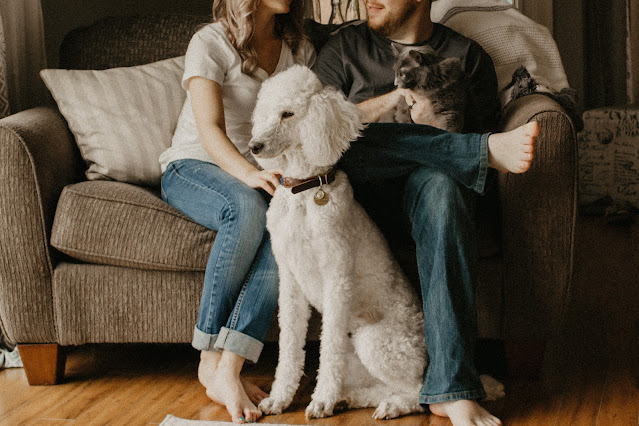Decoding Canine Slumber: Understanding How Dogs Sleep

Understanding How Dogs Sleep: So, you think you’ve got your furry friend all figured out, huh? Well, think again. When it comes to the mysterious world of canine slumber, there’s a lot more going on than meets the eye. Sure, you might catch your dog snoozing away for hours on end, but have you ever wondered what’s really happening while they’re catching those Z’s?
Get ready to have your mind blown as we uncover the secrets behind how dogs sleep. From their unique sleep cycles to their intriguing dream patterns, there’s a whole world of canine slumber just waiting to be discovered. So, buckle up and prepare to be amazed, because the truth about your dog’s sleep habits is about to be revealed.
The Sleep Cycle of Dogs
The sleep cycle of dogs consists of distinct stages that contribute to their overall sleep duration and quality. Dogs have unique sleeping patterns and positions that serve various purposes. One of the primary reasons dogs sleep is to conserve body heat. They have evolved to curl up in a ball or tuck their noses under their tails to keep warm.
Additionally, dogs often exhibit different sleeping habits based on their body language. When they lie on their back with their paws in the air, it signifies that they feel safe and secure in their environment. On the other hand, if a dog sleeps with their legs extended and their body stretched out, it suggests that they are comfortable and relaxed.
Dogs also experience REM (rapid eye movement) sleep, which is associated with dreaming. During this stage, their eyes move rapidly, and they may twitch or make noises. It is important to note that dogs may dream about their daily activities, such as running or playing. So, rest assured, if you see your dog moving while sleeping, it is perfectly normal. Understanding your dog’s sleep cycle and recognizing their unique sleeping habits can help you provide a comfortable sleep environment for them. This, in turn, can improve their sleep quality and overall behavior.
Factors Affecting Dog Sleep Patterns
As we explore the factors that influence dog sleep patterns, it is important to understand the various elements that can impact the duration and quality of their sleep. Dogs, like humans, require a comfortable sleeping environment to feel at ease and get a good night’s rest. Sleep duration can vary based on age, breed, and the individual dog. Puppies and older dogs tend to sleep longer hours compared to their adult counterparts.
One crucial aspect of dog sleep is REM sleep, which stands for Rapid Eye Movement. This stage is essential for their overall health and well-being. Interrupting REM sleep can lead to behavioral issues in dogs. Sleep disorders such as insomnia, sleep apnea, and narcolepsy can also affect a dog’s sleep patterns. Proper diagnosis and treatment are necessary to address these issues and ensure restful sleep for the dog.
Creating a sleep-friendly environment is vital for dogs to achieve quality sleep. Providing a comfortable sleeping area with appropriate bedding and considering factors like temperature and noise levels can significantly improve their sleep. Establishing a consistent sleep routine can also help regulate their sleep patterns.
Dogs’ sleeping positions and behaviors offer valuable insights into their comfort needs. Various factors, such as their instincts and physical well-being, can influence their choice of sleeping position. Some common sleeping positions include sleeping on their belly, curled up in a ball, or sprawled out on their back. By observing these positions, owners can better understand their dog’s comfort preferences and make necessary adjustments to their sleep environment.
Understanding Canine Dreaming
Canine dreaming, a fascinating aspect of dog sleep, involves the experience of REM (Rapid Eye Movement) sleep and the accompanying behaviors that indicate their dream state. During REM sleep, dogs may exhibit various movements, such as twitching, wagging their tails, or making noises, which suggest that they are actively dreaming. These dream behaviors are similar to those observed in humans during REM sleep.
Dogs’ sleep positions can also provide insight into their dream state. When dogs sleep on their back with their belly exposed, it indicates a sense of comfort and security. This position allows for complete relaxation of their furry body, which is essential for a restful sleep. Dogs may also curl up or lie on their side, depending on their individual preferences and physical or psychological needs. These sleep positions are often chosen to promote warmth, maintain a protected posture, or alleviate any discomfort they may be experiencing.
It is important to note that dogs, like humans, can experience sleep disorders. Conditions such as insomnia, sleep apnea, or narcolepsy can disrupt their sleep patterns. These disorders can be caused by underlying medical conditions, stress, or environmental factors. It is crucial to observe any symptoms of sleep disorders in dogs, such as excessive daytime sleepiness, loud snoring, or sudden episodes of falling asleep, and seek proper diagnosis and treatment from a veterinarian.
To improve a dog’s sleep quality and overall behavior, it is recommended to create a sleep-friendly environment. This includes providing a comfortable and quiet sleeping area, considering temperature, lighting, and noise levels. Regular exercise and mental stimulation during the day can also contribute to better sleep. By understanding a dog’s sleeping habits and positions, such as circling, digging, and preferred sleeping positions, we can gain valuable insights into their overall health, comfort, and behavior.
The Mystery of Twitching and Barking in Sleep
During a dog’s REM sleep, they may exhibit various movements and vocalizations, such as twitching and barking, which are natural behaviors associated with dream activity. Twitching and barking in sleep are intriguing phenomena that have puzzled dog owners for years. It is important to understand that these behaviors are completely normal and are indicative of a dog’s healthy sleep patterns.
When a dog is in deep sleep, their body enters the REM stage, which is characterized by rapid eye movement and increased brain activity. During this stage, dogs may twitch their legs, wag their tails, or even vocalize. These movements and sounds are believed to be a result of their dream activity. It is fascinating to observe how dogs can mimic their waking behaviors even while they are asleep.
The mystery of twitching and barking in sleep can be attributed to the complex connection between a dog’s brain and their behavior. Dogs have a unique ability to experience dreams just like humans, and these dreams may evoke various emotions and sensations. For instance, a dog may twitch their legs as if they are running or chasing something in their dream. Similarly, barking during sleep may indicate that a dog is dreaming about a situation that elicits a vocal response.
It is important to note that twitching and barking during sleep should not cause alarm or concern. These behaviors are a natural part of a dog’s sleep cycle and typically indicate that they are experiencing a sense of relaxation and comfort. Interrupting a dog’s REM sleep can lead to behavioral issues and restlessness, so it is crucial to let them complete this phase of sleep undisturbed.
Common Dog Sleeping Positions
When it comes to common dog sleeping positions, there are several important factors to consider. Sleep positions can provide insight into a dog’s overall health and comfort, as well as their behavior and psychological needs. By observing the various sleep positions a dog may assume throughout the night, you can gain a better understanding of their well-being and ensure their needs are being met.
Sleep Positions and Health
Dogs exhibit a variety of sleep positions, which can provide valuable insight into their overall health and well-being. Next time you catch your dog sleeping, pay attention to their sleep position as it can reveal important information. For instance, a dog that sleeps with their legs stretched out may indicate a high level of trust and a sense of security. On the other hand, dogs that sleep curled up in a ball may be trying to conserve body heat or feel more protected.
Lying on their side can indicate comfort and relaxation. It’s important to note that individual dogs may have their own preferences for sleep positions based on their instincts, physical needs, and overall comfort level. By observing and understanding your dog’s sleep positions, you can gain insights into their health, comfort, and potential sleep disorders.
Sleeping Habits and Behavior
One important aspect of understanding dogs’ sleeping habits and behavior is to observe the various positions they assume during sleep. These positions can provide insights into your furry friend’s comfort, sense of security, and overall well-being. Dogs may choose to sleep in different positions based on their natural instincts and individual preferences.
One common sleeping position allows dogs to curl up, with their bodies tucked in and their heads resting on their paws. This position helps dogs conserve body heat and protect vital organs. Another position dogs may choose is lying on their side, indicating a sense of relaxation and trust. Some dogs may sprawl out on their stomachs, ready for play or displaying a sense of protection. Occasionally, you may catch your furry friend sleeping on their back with their belly exposed, which can indicate a deep level of comfort and bonding. By observing these various sleeping positions, you can gain a better understanding of your dog’s sleeping habits and behavior.
The Meaning Behind Dog Sleeping Positions
Now let’s explore the meaning behind different dog sleeping positions. When a dog sleeps on their back, it indicates a high level of comfort and trust in their surroundings. Sleeping curled up in a ball in a position dogs often assume protects their vital organs and conserves body heat. Lastly, when a dog sleeps with their belly on the ground, it suggests a sense of vulnerability and submission. Understanding these positions can provide valuable insights into a dog’s emotions and overall well-being.
Sleeping on Back
Sleeping on their back, dogs indicate comfort and safety in their surroundings. This position signifies a state of relaxation and trust. Adult dogs typically feel safe enough to expose their belly while sleeping on their back. Every dog is unique, and some specific breeds may be more inclined to sleep in this position, such as the Bichon Frise and Cavalier King Charles Spaniel.
When dogs sleep on their backs, they often extend their legs, both front and back, and may even sleep on their side with their legs splayed out. This posture allows dogs to cool off, provides relief for sore muscles and joints, and enhances overall comfort. However, precautions should be taken to prevent slips or falls from elevated surfaces and to monitor for any signs of discomfort or pain when dogs sleep on their backs.
Curled up Position
The curled-up position assumed by dogs when they sleep serves multiple purposes, including conserving body heat and providing a sense of security. Dogs may curl up in a ball to protect their vital organs and maintain warmth. This instinctual behavior can be traced back to their ancestral roots as pack animals.
By curling up, dogs create a barrier between themselves and the outside world, mimicking the protection they would receive from their pack. This position also reflects a dog’s need for trust and love, as feeling safe and secure is essential to their overall well-being. Senior dogs, in particular, may prefer this position due to its comforting nature. When observing your furry friends curled up, it is essential to remember that this position serves a dual purpose of physical and psychological comfort.
Belly to the Ground
After understanding the curled-up position dogs assume when they sleep, it is important to explore the meaning behind another common dog sleeping position known as ‘Belly to the Ground.’ When dogs choose to sleep on their back with their belly touching the ground, it signifies a sense of comfort and relaxation. This position allows dogs to fully stretch out and release tension in their muscles.
By lying on their back, dogs expose their vulnerable belly, showing trust and a feeling of safety in their surroundings. Additionally, sleeping on their back with their legs extended can help alleviate pressure points and promote better blood circulation. This position also allows dogs to regulate body temperature more efficiently, as their belly is in direct contact with a cool surface. Overall, the decision to sleep on their back demonstrates a state of contentment and well-being in our canine companions, which is essential for their overall health.
How Many Hours Do Dogs Sleep?
With an average duration of 12-14 hours per day, dogs sleep more than most other animals. Puppies and older dogs may even sleep up to 18-20 hours a day. The exact amount of sleep can vary based on factors such as breed, age, and individual differences among dogs. Have you ever seen your dog curl up in their designated sleeping area and snooze away? Well, they are likely entering what we can call “Canine Dreamland”.
Dogs, like humans, experience different stages of sleep. One of these stages is called REM (Rapid Eye Movement) sleep, which is associated with dreaming. Puppies and older dogs have more REM sleep compared to adult dogs. Interrupting a dog’s REM sleep can lead to behavioral issues and restlessness. So, it’s important to let them sleep peacefully!
The number of hours a dog sleeps each day is not only influenced by their age and breed but also by their activity levels and overall health. Dogs with higher activity levels may require more sleep to recharge their energy levels. Similarly, dogs with certain health conditions may need extra rest to recover and heal.
Another factor that can affect a dog’s sleep is their body temperature. Dogs have a higher body temperature than humans, so they may seek out cooler areas to sleep. Providing a comfortable sleeping area with proper ventilation can help ensure a good night’s sleep for your furry friend.
Improving Your Dog’s Sleep Quality
To further enhance your dog’s sleep quality, it is crucial to implement strategies that optimize their sleeping environment and promote overall well-being. Providing a designated sleeping area for your dog can create a sense of security and comfort. This area should be quiet, away from distractions, and offer a cozy and comfortable bed. Optimal temperature is also important, as dogs are sensitive to extreme heat or cold. Keep the sleeping area well-ventilated and at a temperature that is comfortable for your dog.
Regular exercise is vital for improving your dog’s sleep quality. Engaging in physical activities helps to tire them out, allowing for a more restful sleep. Taking your dog for walks, playing fetch, or engaging in interactive play sessions can help them expend energy and promote better sleep.
Understanding your dog’s sleeping positions and behaviors can provide insights into their comfort and overall health. Dogs often sleep in different positions, such as curling up, circling before laying down or sleeping on their back with their belly exposed. These positions allow them to conserve body heat, protect their vital organs, and feel safe and secure. Observing your dog’s preferred sleeping position can help you better understand their needs and provide an environment that promotes quality sleep.
As pet parents, it is important to create a bedtime routine for your dog. Establish a consistent sleep schedule and stick to it. This will help regulate their internal clock and promote more restful sleep. Additionally, avoid feeding your dog a large meal right before bedtime, as this can interfere with their sleep. Instead, provide a small, light snack if necessary.
Understanding How Dogs Sleep Frequently Asked Questions
What Does the Way Dogs Sleep Say About Them?
The way dogs sleep can reveal insights about their personality traits, comfort level, and overall health. Different breeds have unique sleeping patterns and behaviors, while age can impact their sleeping habits. Creating a comfortable sleep environment is crucial for their well-being and behavior.
What Is the Sleeping Position of a Sick Dog?
The sleeping position of a sick dog can vary, as illness affects their comfort. Changes may indicate pain or discomfort. Observing their position is important to provide a supportive environment and help them find comfort.
What Position Do Dogs Lay in When in Pain?
When dogs are in pain, they may lie in different positions to seek comfort. Observing their sleeping positions can give insights into their well-being. Providing a comfortable sleep environment and monitoring changes in sleeping patterns are important for dogs in pain.
Why Do Dogs Put Their Bum Towards You When Sleeping?
When dogs put their bum towards you while sleeping, it signifies their trust and comfort in their surroundings. It can also be a way for them to cool off or protect their organs.
Conclusion
In conclusion, understanding how dogs sleep is crucial for their overall health and well-being. Dogs sleep for an average of 12-14 hours per day, with puppies and older dogs sleeping even longer. The duration of sleep varies depending on the breed and individual dogs. Dogs experience REM sleep, associated with dreaming, and may exhibit twitching and barking during this stage. By creating a sleep-friendly environment, providing a designated sleeping area, and establishing a consistent sleep routine, we can improve a dog’s sleep quality and behavior.








